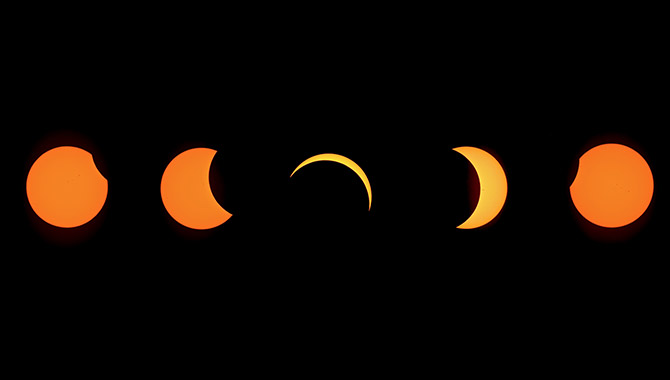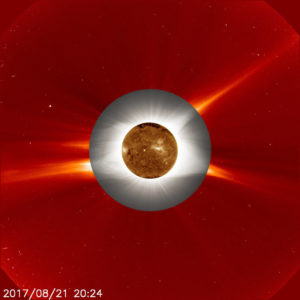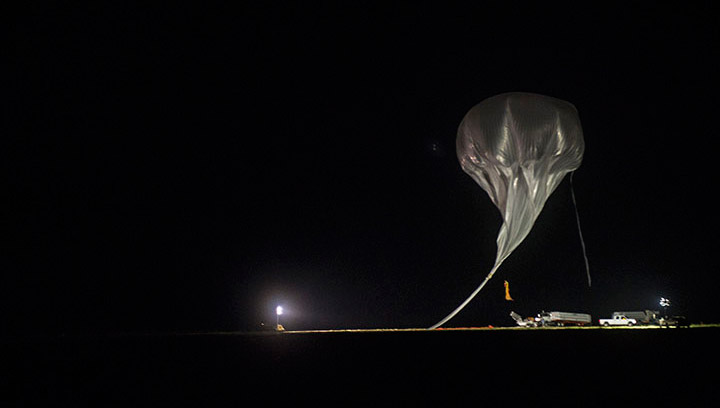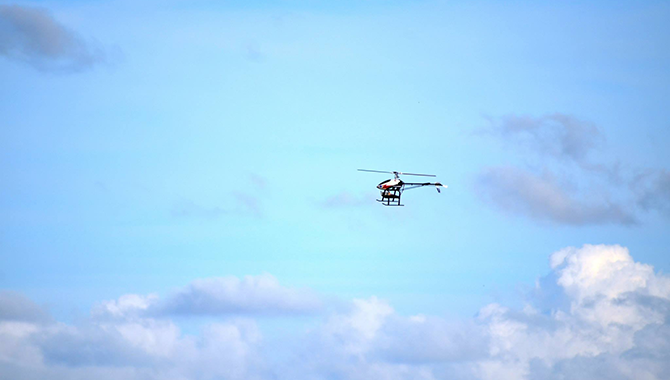
Collage of photos showing eclipse phases taken in Cincinnati, OH, on August 21, 2017.
Photo Credit: NASA/Roger Forsgren
On August 21, 2017, the U.S. experienced the first total solar eclipse to span the nation in 99 years. Scientists, from astrophysicists to students, collected novel data during the event.
The path of totality—the section of the country that experienced a total solar eclipse—was about 70 miles wide and crossed parts of 14 states. The full eclipse was first visible in Oregon just after 1:00 p.m. ET and last seen in South Carolina nearly two hours later.
In most locations, the total eclipse lasted for about two minutes. During that time, the sky darkened, street lights illuminated, and crickets, whose behavior is affected by changes in sunlight, began to chirp. The eclipse lasted longest in Hopkinsville, Kentucky, where the moon covered the sun for two minutes and forty seconds.
With less than three minutes of observation at any one site, time was of the essence for scientists across the country as they sought to take advantage of the brief opportunity to view the sun’s atmosphere—the corona—in visible light. This was especially important because a total eclipse offers the chance to examine the lower corona, which isn’t observed by space-based missions.
“Some of the NASA missions have a data gap. That’s the lower part of the corona where we really want to study,” said Matt Penn, an astronomer at the National Solar Observatory in Tucson, Arizona, speaking with NASA Science Mission Directorate (SMD) Associate Administrator Thomas Zurbuchen and others at the Washington, DC, Newseum in June. “The sun is hiding some science in that data gap that we want to get at, and that’s what we’re going to try to do with the eclipse data.”

This compilation of images includes a ground-based image of the lower corona taken during the total solar eclipse (gray middle ring) superimposed over a space-based image of the corona (red outermost ring), as seen by the ESA/NASA Solar and Heliospheric Observatory (SOHO). At the center is an image of the sun’s surface taken by NASA’s Solar Dynamics Observatory in extreme ultraviolet wavelengths of light.
Credits:
Innermost image: NASA/SDO
Ground-based eclipse image: Jay Pasachoff, Ron Dantowitz, Christian Lockwood, and the Williams College Eclipse Expedition/NSF/National Geographic
Outer image: ESA/NASA/SOHO
Scientists hope to use data from the eclipse to answer questions about the corona, including why it is much hotter—a million degrees warmer—than the sun’s surface and what causes solar wind to accelerate in this region. The solar wind is a steady stream of charged particles and magnetic fields released from the sun that is punctuated by huge eruptions of material, such as solar flares and coronal mass ejections (CMEs). Space weather, caused by these flares and CMEs, is of particular interest because it can affect the performance and safety of spacecraft, communications satellites, GPS, radar, and astronauts in orbit. Learning more about the behavior of the corona will improve the ability to predict space weather and potentially lessen its impact on technologies originating from Earth.
“If you want to know if a storm is going to hit a particular city, and when it’s going to hit a city, you need to understand the wind on the earth. And so, in a similar way, we’re studying the solar wind to try to better predict what happens in space with solar storms and space weather,” said Penn.
NASA funded 11 studies to observe the sun during the eclipse. These included experiments to test new technology, imaging studies at different locations in the path of totality, and an air-based effort in which two NASA WB-57 planes viewed the eclipse, in both the visible and infrared, for roughly eight minutes to examine how energy moves through the corona. Their goal was to capture the clearest image yet of the sun’s atmosphere. They also obtained thermal images of Mercury to assess temperature variances on the planet’s surface.
Three NASA solar missions were in position to observe the eclipse as well: the joint JAXA/NASA mission Hinode, the Solar Dynamics Observatory (SDO), and the Interface Region Imaging Spectrograph (IRIS). In addition, the National Science Foundation and other organizations observed the event from the ground. Data from the NASA missions will be compared with ground-based observations to enhance understanding of solar activity.
“Citizen science” was another important aspect of the eclipse data-collection effort. One example, the Eclipse Ballooning Project, brought together 50 student teams across the nation to live-stream high-altitude video from multiple locations in the path of totality.
“The goal of the Eclipse Ballooning Project is to connect to a basic human sense of wonder by providing live footage from the edge of space,” said principal investigator Angela Des Jardins, Montana State University, Bozeman. “Nobody had ever live streamed video from one high-altitude balloon of a total solar eclipse before, let alone dozens across a continent.”
Another significant effort was the Citizen Continental America Telescopic Eclipse (CATE) experiment, which involved 250 volunteers located at 68 points across the country with identical equipment taking data during the eclipse. While the total eclipse was only visible for two minutes at any single site, the combined efforts of these citizen scientists will be used to glean critical insight into solar wind.
“[I]f we take data as the shadow of the moon crosses the country and then combine that data into a continuous movie, we can observe the corona for 93 minutes, and therefore see changes that we wouldn’t otherwise detect,” said Penn.
He added, “The thing that excites me the most about this eclipse is that millions of people across the country in the path of totality can walk out on their porch in their slippers and collect world-class data.”
Watch a video about the time pressure faced by scientists studying the corona during the eclipse.









